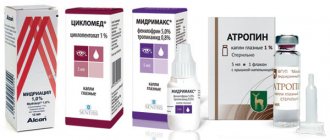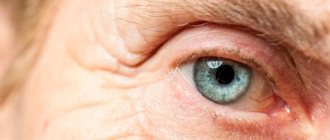Cyclomed is an ophthalmic drug from the group of M-anticholinergics. It has a mydriatic effect, that is, it dilates the pupil by contracting the dilator muscle. Do not confuse this medicine with Tsipromed, an antibiotic that is used to treat inflammatory eye diseases.
Cyclomed eye drops are used for diagnostic and therapeutic purposes. Ophthalmologists use them before examining the fundus. The product can be used from the age of three.
Composition and effect of the drug
The drug Cyclomed contains cyclopentolate hydrochloride, an active ingredient that dilates the pupil. The medicine is released in the form of a 1% solution. This means that 1 ml of the drug contains 10 mg of the active ingredient. Drops contain excipients: water for injection, benzalkonium and sodium chloride, disodium edetate.
The action of the drug is aimed at dilating the pupil.
The effect of using the product appears after 15-20 minutes and lasts on average 7-12 hours.
Sometimes mydriatic phenomena persist throughout the day from the moment of instillation into the eyes.
pharmachologic effect
Cyclopentolate blocks m-cholinergic receptors, thereby promoting tension in the ciliary (ciliary) muscle of the eye and simultaneous relaxation of the muscle that constricts the pupil. Relaxation of the ciliary muscle of the eye leads to the development of paralysis of accommodation - cycloplegia. Temporary paralysis of accommodation helps restore lost eye functions in some eye diseases, and also makes it possible to distinguish a spasm of accommodation from true myopia during diagnosis.
Cyclomed easily penetrates the conjunctiva of the eye. Cyclopentolate reaches maximum pharmacological activity 20-30 minutes after a single instillation of Cyclomed. Reviews of Cyclomed say that the pupil remains dilated for 7-12 hours after instillation of the drug, and in some cases much longer. Residual effects of accommodation paresis may persist for 24 hours after instillation of the drops.
Judging by the reviews, Cyclomed has an antispasmodic effect, reduces the secretion of the gastric glands, salivary, sweat, bronchial glands and pancreas. The drug in therapeutic doses has a stimulating effect on the nervous system (manifests 30-60 minutes after instillation of the drug), promoting an increase in intraocular pressure and a decrease in the tone of the vagus nerve, which leads to the development of tachycardia and a slight increase in blood pressure.
Indications
The drug is prescribed for keratitis, iridocyclitis, uveitis and other inflammatory eye diseases. In children and adolescents, it is used for the diagnosis and treatment of false myopia (spasm of accommodation).
It is used in preoperative preparation for phacoemulsification - cataract surgery. Cyclomed dilates the pupil and facilitates access to the lens of the eye. Thanks to this, the surgeon can perform the operation without damaging the iris. Drops are also used for the diagnosis and treatment of ophthalmic diseases.
The drug affects the eye muscles that regulate the constriction and dilation of the pupils.
Indications for the use of Cyclomed:
- Preparation for ophthalmoscopy. Pupil dilation allows the doctor to clearly examine the fundus and see pathological changes in the retina, choroid, optic nerve, and retinal vessels.
- Definition of refraction - the refractive power of the eye. Cyclomed is dripped into the eyes before fitting glasses or contact lenses. The drug allows you to study the refraction of a patient under conditions of resting accommodation and distinguish true myopia from false. This makes it possible to avoid diagnostic errors and correctly correct vision.
- Inflammatory diseases of the anterior segment of the eye. For scleritis, iritis, iridocyclitis and keratitis, Cyclomed is prescribed to prevent the formation of posterior synechiae - adhesions between the iris and the anterior capsule of the lens. The drug prevents constant movement of the pupil and ensures functional rest of the anterior part of the eye. Thus, the inclusion of Cyclomed in complex treatment speeds up recovery and reduces the risk of complications.
- False myopia. For myopia, Cyclomed is used if it is caused by a spasm of accommodation. The drops relax the ciliary body, relieve its spasm and improve human vision. They prevent the development of true myopia, which is not amenable to conservative treatment.
Manufacturers, prices, release forms
The drug is produced by Indian pharmaceutical companies Sentiss Pharma and Promed Exports.
Cyclomed eye drops are available in the form of a clear, colorless, odorless liquid. One plastic bottle contains 5 ml of the drug. The cardboard package contains a container with medicine and instructions.
You can read the instructions for use here →
Prices for Cyclomed vary in different pharmacies. The average cost of a medicine is 575 rubles. You can buy it only with a prescription.
Dosage and administration
For adults and children, Cyclomed is prescribed by an ophthalmologist.
- Before examining the fundus, the doctor instills 1-2 drops of medicine into the patient’s eyes three times. The intervals between instillations are 10 minutes. To determine refraction in children, the medicine is dripped three times with an interval of 15-17 minutes.
- For inflammatory eye diseases and false myopia, drip the drug 1-2 drops three times a day. The duration of the course of treatment is determined by the attending physician.
Do not use drops without first consulting an ophthalmologist.
Reviews
Most often, the drug is prescribed to adults and children for the purpose of diagnosis and early detection of eye diseases. After becoming familiar with the side effects, many people have a negative attitude towards it.
A procedure with an ophthalmologist will help dispel fears, after which you can make sure that there are no negative consequences if the drug is used correctly.
You can read about the effectiveness and safety of the drops on forums and blogs written by adults who have undergone the procedure. Most parents note that children do not cry after installing drops.
The general public opinion agrees that cyclomed does not have negative consequences for the body; it is equally well tolerated by people of all ages.
Contraindications and side effects
The drug cannot be used for glaucoma and traumatic paresis of the muscle that constricts the pupil. In all people over 40 years of age, before instilling Cyclomed, the doctor measures intraocular pressure, since at this age the risk of developing glaucoma increases.
A sharp dilation of the pupil can cause closure of the anterior chamber angle and lead to an increase in intraocular pressure.
This phenomenon is called an attack of angle-closure glaucoma.
In the first hours after using the medicine, side effects are possible:
- temporary decrease in visual acuity;
- increased intraocular pressure in patients with primary glaucoma;
- mild discomfort and redness of the eyes;
A possible adverse reaction is burning in the eyes.
- dizziness, weakness, increased heart rate.
Teenagers and drug addicts use Cyclomed as a drug.
They drip liquid into the nose. The medicine is quickly absorbed into the blood, affects the nervous system and causes hallucinations and a state of euphoria. The drug is much more dangerous than opiate drugs. It does not stimulate opioid receptors in the brain, and its use leads to serious neurological damage. Over time, Cyclomed becomes addictive, and you have to drip it in ever larger quantities to achieve a narcotic effect.
Use as a drug, consequences
By instilling this medicine incorrectly, even in the intended place, you can significantly harm yourself, since there is a direct effect on the functions of the nervous system. Even a few extra drops of medication can significantly worsen your health situation and cause unpredictable and severe side effects; be prepared to need the help of a doctor. So, if the medication is administered intranasally, it will become like a drug with obvious dissociative and hallucinogenic properties. If a person has consumed a substance through the nose, then he knows that he will begin to drink quickly, since drops enter the systemic bloodstream through the nasal mucosa faster, which means that the rush is much stronger.
The first signs that cyclomed causes side effects of narcotics: hallucinations appear (the patient seems to see something that is not really there, and a distorted consciousness completes the picture), disorientation in space appears (a person may forget where he is, coordination of movements may become confused) , speech is impaired, words are pronounced slurred. The pupils are often dilated and do not respond to light; in general, the addict loses control over his behavior. Moreover, the choice of cyclomed as a substance to achieve an altered narcotic consciousness is not advisable, since this state does not cause euphoria and dependence, but rather severe disturbances in the functionality of the nervous system. Especially desperate individuals, instead of the recommendation to drip 1 drop up to 3 times a day, can use the entire bottle intranasally at a time.
To avoid accidental contact with the substance in the mouth or nose, it should be kept out of reach, especially for children. If there is a person in the house who requires increased attention to himself, the medicine must also be hidden from him securely, because old people can often confuse their medicines with others due to poor eyesight. Susceptibility to the medication is individual in each case; some will actually get sick, while others will simply be poisoned. In any case, an overdose does not go away without a trace; it is accompanied by blurred vision, tachycardia, nausea and weakness.
Reviews about the drug
Reviews from doctors and patients will help you get a more complete understanding of Cyclomed.
Evgenia Vladimirovna Korneeva, ophthalmologist with 17 years of experience:
“I use this drug to dilate my pupils before ophthalmoscopy. It provides a good and short-lived mydriatic effect. The very next day, patients’ vision is completely restored, whereas after Atropine, blurriness persists for a whole week.”
Review from patient Semen Shuvalov (37 years old) from Voronezh:
“Cyclomed was dripped at an appointment with an ophthalmologist during an examination. First there was a burning sensation, then my vision worsened. Everything around seemed blurry and floating. At first I was scared, but soon the unpleasant symptoms disappeared. True, I had to give up driving for the whole day.”
Review from Maria, mother of 8-year-old Vitya:
“My husband and I recently noticed that our son began to squint. We contacted a specialist. They explained to us that we might have to pick up glasses. The doctor prescribed Cyclomed and advised me to take it for several weeks. He says he’ll double-check everything after that. Perhaps your vision will improve. We have been undergoing treatment for three weeks now. The son noticed that he began to see better. At least he squints less. We are glad. We hope we won’t need glasses.”
Analogs
Analogues of Cyclomed are divided into two groups. The first includes drugs containing the same active substance (cyclopentolate); the second includes products with a similar effect, but with other active ingredients.
Of the analogues in composition, Cycloptic eye drops are the most widely used. Available in 5 ml bottles. The average cost of a medicine is 250 rubles.
Analogues in action:
- Mydriacyl drops. Contains tropicamide as an active ingredient. Causes a short-term dilation of the pupil. Suitable for diagnostic purposes. One bottle of 1% solution with a volume of 15 ml costs an average of 320 rubles.
- Atropine drops. Powerful mydriatic with long-lasting action. It is no longer used for diagnostic dilatation of pupils, as it causes long-term visual impairment. Used to treat spasm of accommodation in children. A 5 ml bottle costs 55 rubles.
- Midrimax drops. A combined mydriatic drug containing an anticholinergic agent (tropicamide) and an adrenergic agonist (phenylephrine). Used before ophthalmoscopy, surgical (including laser) intervention. The cost of a 5 ml bottle is on average 580 rubles.
Cyclomed's analogue is Midrimax.
Separately, Irifrin is a selective alpha-adrenergic agonist. The drug does NOT increase intraocular pressure. It is used to treat false myopia and true myopia in people with increased visual load.
Side effects and overdose
Side effects from taking this drug include redness of the eyes, dizziness, headaches, temporary decrease in visual acuity, nausea.
If the drug was taken orally (which should not be allowed under any circumstances), then the following may occur:
- Loss of a person in space and time;
- Absent-mindedness;
- Nervousness, frequent mood swings;
- Lack of moisture in the mucous membranes;
- Deterioration in the quality of vision, up to temporary blindness;
- Decreased concentration and general weakness.
Tips and tricks
- After dilation of the pupil, do not drive for 24 hours. If you drive a car, use public transport on the day of the examination.
- Do not send your child to school immediately after a visit to the ophthalmologist. Cyclomed causes temporary visual impairment. The child will see the world around him blurry and will not be able to fully study in class.
- Before buying a medicine, check the expiration date. After opening, store the bottle out of the reach of children at a temperature below 25 degrees.
- Do not allow Cyclomed to get inside or on mucous membranes. Penetration of the drug into the bloodstream causes complications and side effects.
- Use the drug only after consultation with an ophthalmologist, strictly observing the dosage.
How the drug works and what its misuse leads to
If the dosage prescribed by the doctor for the patient is only 1 drop, then the drug addict can drop a whole bottle. A substance that can cause malfunctions of the central nervous system, disorders of organs and systems, as well as death at a relatively small dosage is called poison. Poisons quickly or slowly poison the body. Uncontrolled use and significantly exceeding the dosage is dangerous and can lead to overdose and death. Symptoms of poisoning:
- dizziness;
- drowsiness;
- nausea and vomiting;
- visual impairment;
- disruption of the heart.









